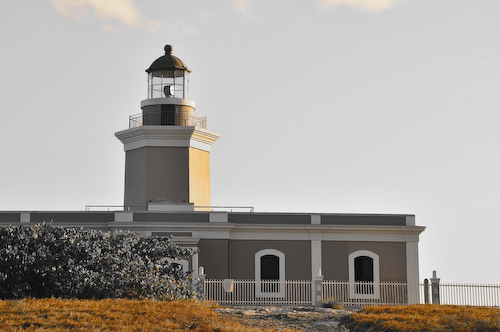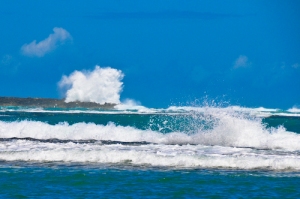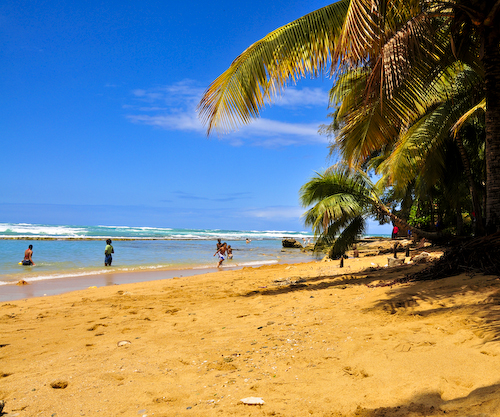Four Beaches and an Alcapurria
Today we set out to hit the corners of Puerto Rico, visiting four beaches: Playa de Ponce, Luquillo, Cabo Rojo, and Pinones. Each beach has its own distinctive flavor, from pebble-strewn to talcum powder sand and clear water.
Our first stop was Playa de Ponce, which is on the arid southern shore of Puerto Rico. The beach sand, shown above, isn’t actually sandy. It is a collection of roughly crushed coral and seashells which make for rather uncomfortable beach lounging, but the opportunity to collect sea shells is quite good.
This was the view from my rather painful spot on the beach wall. Why painful, you ask? I dropped a 10 pound glass jar of sugar on my right foot this morning while making (what else?) my famous french toast, fracturing the next-to-last toe. Rather than go to the hospital and ruin the day for everyone, I hobbled along and shot my D300 from where ever I found myself plopped.
Ponce is well worth a visit, even if the beach isn’t ‘all that’. Ponce, the second largest city in Puerto Rico outside of the San Juan metropolitan area, is named after Juan Ponce de León y Loayza, the grandson of Spanish conquistador Juan Ponce de León. Ponce is often referred to as La Perla del Sur (The Pearl of the South) and La Ciudad Señorial de Puerto Rico (Majestic city of Puerto Rico).
Regular readers of this journal will recognize my good friend Jesus, who was our chauffeur throughout the day. Jesus is a true friend – he drove us 500 miles and we enjoyed his company immensely. Jesus brought his dog Roger along for the ride, who was well behaved all through our long day.
My daughter collected a few shells from the beach in Ponce. This photo was finished with a washed out look, and I really like the result.
Tucked away in the southwest corner of the island is the community of Cabo Rojo. There is a national seashore here, administered by the National Park Service. It is said that Cabo Rojo obtained its name from the considerable amount of minerals found in its coasts that made the waters look reddish. Cabo is the Spanish word for tip and analogous to the English word Cape in this context. The word rojo, translates to red. According to legend, the name was given by Christopher Columbus himself, although this is highly unlikely. The first church, founded in 1783, was called San José. The present-day main catholic church is called San Miguel Arcángel located in the town’s square.
Located at the southwestern tip of the island of Puerto Rico, Los Morrillos Lighthouse was constructed in 1882 in order to guide passing ships through the southeast entrance from the Caribbean Sea through the treacherous Mona Passage into the Atlantic Ocean. The lighthouse is located over a while lime cliff which is surrounded by salt water lagoons and marshes. The cliffs surrounding the lighthouse drop over 200 feet into the ocean.
The lighthouse’s architecture is distinguished by its simplicity, with minimal decoration and an unelaborated cornice repeated through the structure. The illuminating apparatus is housed in a cast-iron, copper and glass lantern. The lenticular lens was manufactured by the French firm Sautter, Lemonnier and Company.
Originally, the lighthouse was manned by two keepers and an engineer, who lived on the grounds with their families. In 1967 the lighthouse was renovated and its operation is currently completely automated. The structure itself has been abandoned for decades, although recently the local government as well as local civic groups, such as Caborrojeños Pro Salud y Ambiente, are pushing towards turning the old lighthouse keeper’s house into a museum. The project was taken over by the municipality, an action that lost U.S. Federal government funds that had been assigned for it. The municipality took over the renovations, which, according to critics, has irrevocably damaged the historical significance of the internal structure.
Here is the view down the 200 foot cliffs, over the red rocks below, and into the foaming sea. Cabo Rojo is just beautiful and well worth the drive across Puerto Rico.
The third beach on our tour was in Luquillo, Puerto Rico. Luquillo is known as “La Capital del Sol” (sun capital) and “La Riviera de Puerto Rico” (Puerto Rico’s riviera). Luquillo was founded in 1797 by Cristóbal Guzmán. The town was named after the Indian cacique Loquillo, who died a few years after the last Indian rebellion in 1513.
Here is my daughter relaxing in the gentle waves at Playa de Luquillo. A huge plantation of majestic coconut palms lining the beach shades more than a mile of fine sand. It is one of the most popular public beaches in the San Juan area. It offers cafeterias, public bathrooms with showers, access for disabled people, and an ample parking lot. This is one of the public beaches most frequented by the locals.
Finally, we visited Pinones, Puerto Rico. Vacia Talega beach is part of the long strip of beach comprising the ‘Pinones Nature Reserve’ just east of the San Juan Airport on Road 187. It is a very scenic way to drive east from San Juan.
Allthough it’s very beautiful this area is notorious for theft and you should never be on the beach alone nor park your car in a deserted area. If there are others at the beach, you’ll be fine here. Remember thieves can spot tourists by their rental cars and are tempted to open the trunk to see what cameras and wallets you’ve left for them! Despite the environmental challenges here, the beach is just beautiful.
There is a reef just offshore which provides a spectacular aerial show when the surf is up. I estimated these breaks at 30 to 40 feet high – awesome!
The beach at Pinones is a mixture of coarse sand and coral. Although this area bears caution by tourists, the views are amazing and there are numerous fast food vendors nearby selling alcapurrias and other local treats. Alcapurria is a dish from Puerto Rico made from a mixture of ground plantains and yautia, filled with ground beef or crab meat and deep fried in vegetable oil. Many Puerto Ricans enjoy this dish and are often found eating it at the beach with friends.
My daughter, shown relaxing in Pinones. This photo was finished with an acid wash treatment which I rather like. Shortly after this photo was taken we decided to hit the nearby stands where we scored some freshly made fried goods for the ride home. Mission accomplished!















[…] is about 30 minutes east of San Juan on the northeast coast of Puerto Rico and, as covered in a previous post, it is a very popular destination for natives and visitors […]
La Parrilla! Heaven in Luquillo… « Windward Journey: A Year of Discovery said this on May 18, 2008 at 2:50 am |